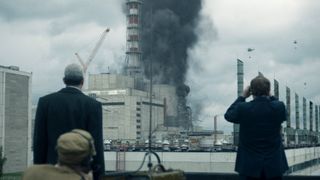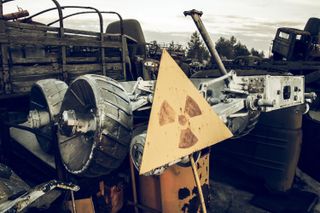5 Weird Things You Didn't Know About Chernobyl

The Chernobyl nuclear power plant exploded more than three decades ago, in 1986, but you can watch it unfold on HBO's TV miniseries "Chernobyl," which premiered earlier this week.
While most people know the general story — that due to human error, the nuclear reactor exploded and unleashed radioactive material across Europe — few know the nitty-gritty details. Here are five weird facts you probably didn't know about Chernobyl. [Images: Chernobyl, Frozen in Time]
1. Similar to Hiroshima
About 30,000 people were near Chernobyl's reactor when it exploded on April 26, 1986. Those exposed to the radiation are thought to have received about 45 rem (rem is a unit of radiation dosage), on average, which is similar to the average dose received by survivors after the atomic bomb was dropped on Hiroshima in 1945, according to the book "Physics for Future Presidents: The Science Behind the Headlines" (W. W. Norton & Company, 2008) by Richard Muller, a professor emeritus of physics at the University of California, Berkeley.
While 45 rem is not enough to cause radiation sickness (which usually occurs at about 200 rem), it still increases the risk of cancer by 1.8%, Muller wrote. "That risk should lead to about 500 cancer deaths in addition to the 6,000 normal cancers from natural causes."
However, a 2006 estimate from the International Atomic Energy Agency (IAEA), which is associated with the United Nations, calculated much higher cancer fatalities. The IAEA looked at the total distribution of the radiation, which reached across Europe and even to the United States, and estimated that the cumulative radiation dose from Chernobyl was about 10 million rem, which would have led to an additional 4,000 cancer deaths from the accident, Muller wrote.
2. Greatest harm ended within weeks
The initial blast was enormous, but the greatest harm from the radiation happened within the first few weeks. You can think of radiation as fragments that fly outward as a nucleus explodes, like shrapnel from a bomb, Muller wrote.
Just like popped bubble wrap, each nucleus can explode and release radiation only once. Just 15 minutes after the Chernobyl explosion "the radioactivity had dropped to one-quarter of its initial value; after 1 day, to one-fifteenth; after 3 months, to less than 1%," Muller wrote.
Sign up for the Live Science daily newsletter now
Get the world’s most fascinating discoveries delivered straight to your inbox.
"But there is still some left, even today," he noted. "Much of the radiation literally went up in smoke, and only the radiation near the ground affected the population."

3. Dozens of firefighters died
The Chernobyl explosion not only released a lot of radiation; it also started a fire at the power plant. The firefighters who rushed in to stop the flames were exposed to high levels of radiation, and dozens died from radiation poisoning, Muller wrote.
These firefighters were exposed to over 1 quadrillion gammas each. But what does that mean?
Gamma rays — a penetrating kind of radiation that is released from nuclear weapons, dirty bombs and reactor explosions — is like an extremely energetic X-ray. There are about 10 trillion gamma rays in every 1 rem of radiation, Muller wrote.
A person who gets a whole-body dose of 100 rem probably won't notice, as our systems can repair most of this damage without making a person sick. At 200 rem, a person can develop radiation poisoning. Patients who received chemotherapy sometimes experience this type of sickness, leading to side-effects such as hair loss and feeling nauseated and listless. (This nausea is caused, in part, by the body feverishly working to fix the damage caused by the radiation, so it cuts back on other activities, such as digestion, Muller wrote.)
People hit with 300 rem have a good chance of dying unless they get immediate treatment, like a blood transfusion, Muller wrote.
4. There was no containment building
Chernobyl didn't have an important safety measure in place: a containment building.
A containment structure is a gas-tight shell that surrounds a nuclear reactor. This shell, which is usually dome-shaped and made of steel-reinforced concrete, is designed to confine fission products that may be released into the atmosphere during an accident, according to the U.S. Nuclear Regulatory Commission.
If there had been a containment building at Chernobyl, according to Muller's book, "the accident may very well have caused virtually no deaths."
5. There's wildlife there now
The Chernobyl area was evacuated following the explosion; once humans left, wildlife moved in.
The numbers of moose, roe deer, red deer and wild boar living in the exclusion zone are similar to population numbers in nearby uncontaminated nature reserves, a 2015 study found. Wolves are doing especially well, with a population that is seven times the size of wolf populations in neighboring reserves, the study researchers found.
"This doesn't mean radiation is good for wildlife, just that the effects of human habitation — including hunting, farming and forestry — are a lot worse," Jim Smith, the study's observation team coordinator and a professor of environmental science at the University of Portsmouth in the United Kingdom, said in a statement.
However, other scientists pointed out that wildlife levels at Chernobyl are lower than those at other protected regions in Europe, indicating that the radiation is still affecting the area.
- 15 Secretive Places You Can Now See on Google Earth (And 3 You Can't)
- Chernobyl Nuclear Disaster 25 Years Later (Infographic)
- Lessons From 10 of the Worst Engineering Disasters in US History
Originally published on Live Science.

Laura is the archaeology and Life's Little Mysteries editor at Live Science. She also reports on general science, including paleontology. Her work has appeared in The New York Times, Scholastic, Popular Science and Spectrum, a site on autism research. She has won multiple awards from the Society of Professional Journalists and the Washington Newspaper Publishers Association for her reporting at a weekly newspaper near Seattle. Laura holds a bachelor's degree in English literature and psychology from Washington University in St. Louis and a master's degree in science writing from NYU.
